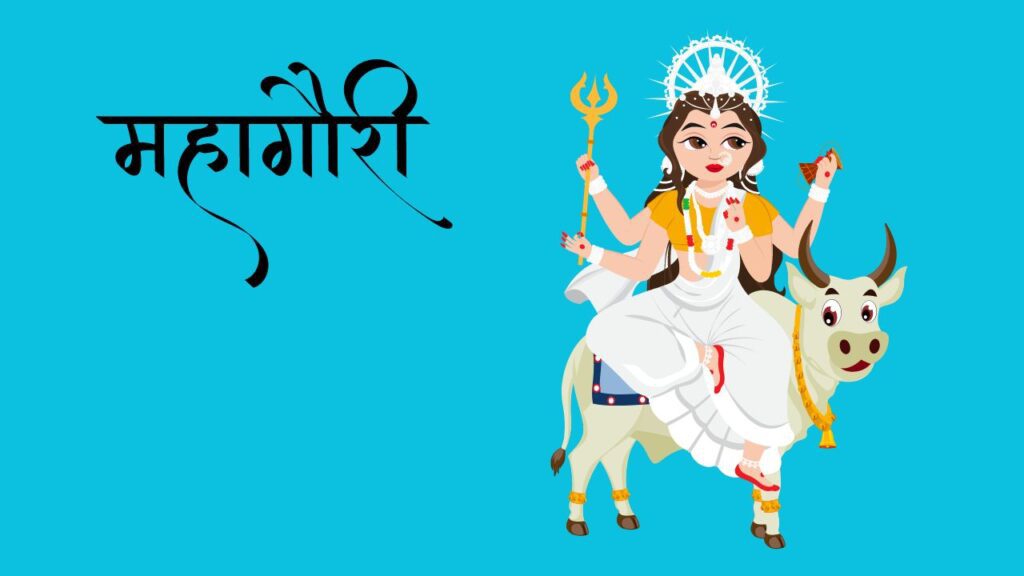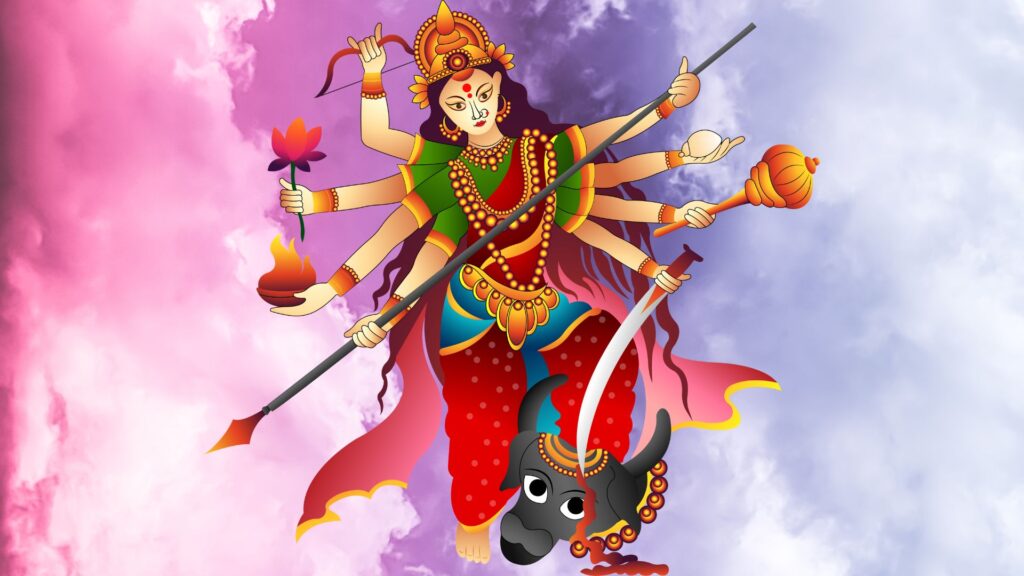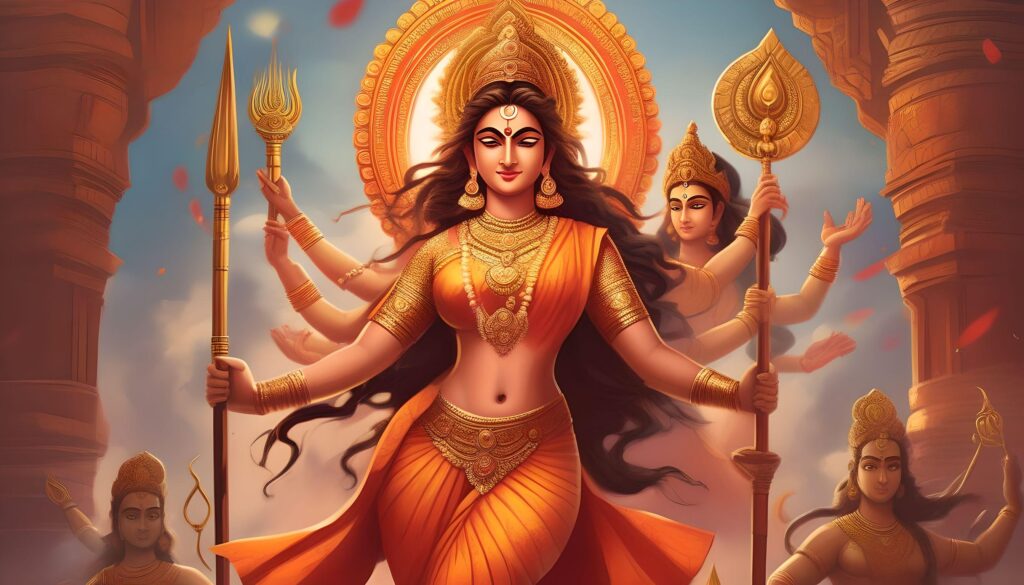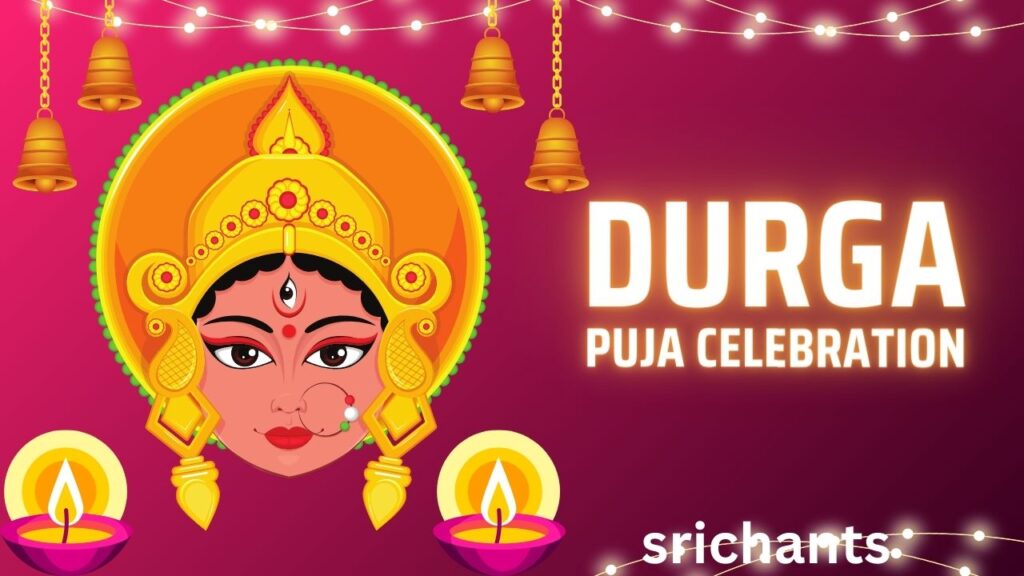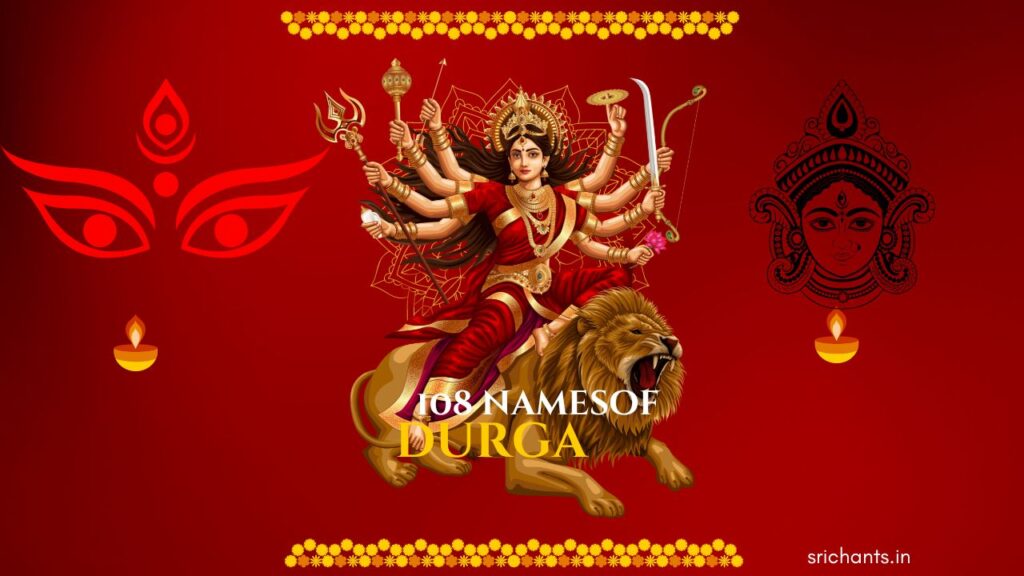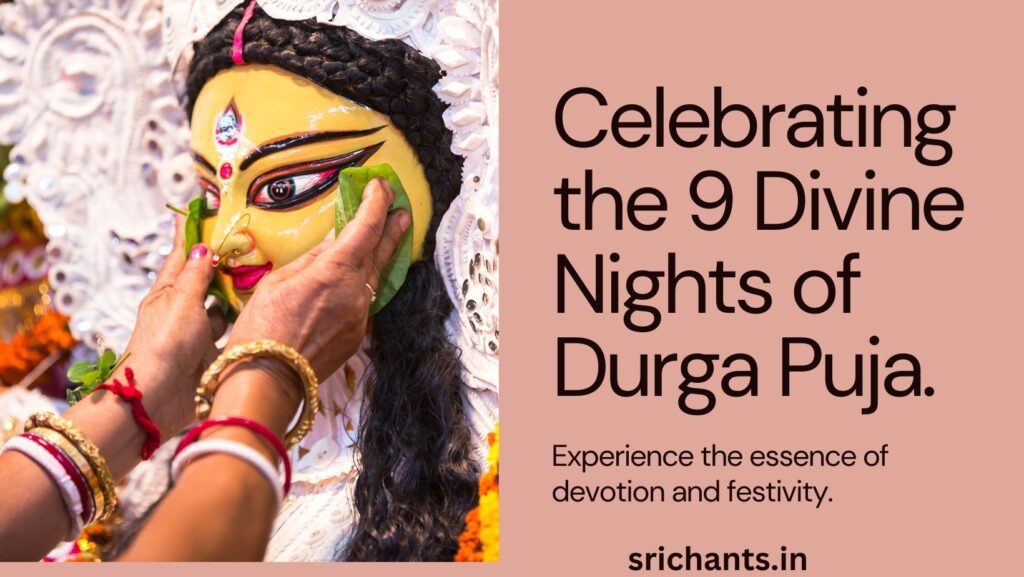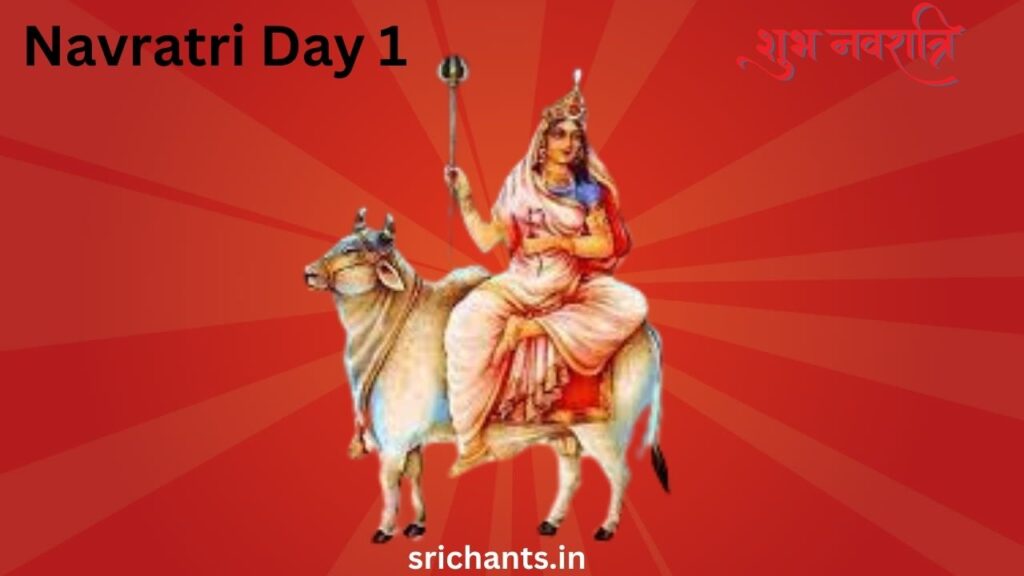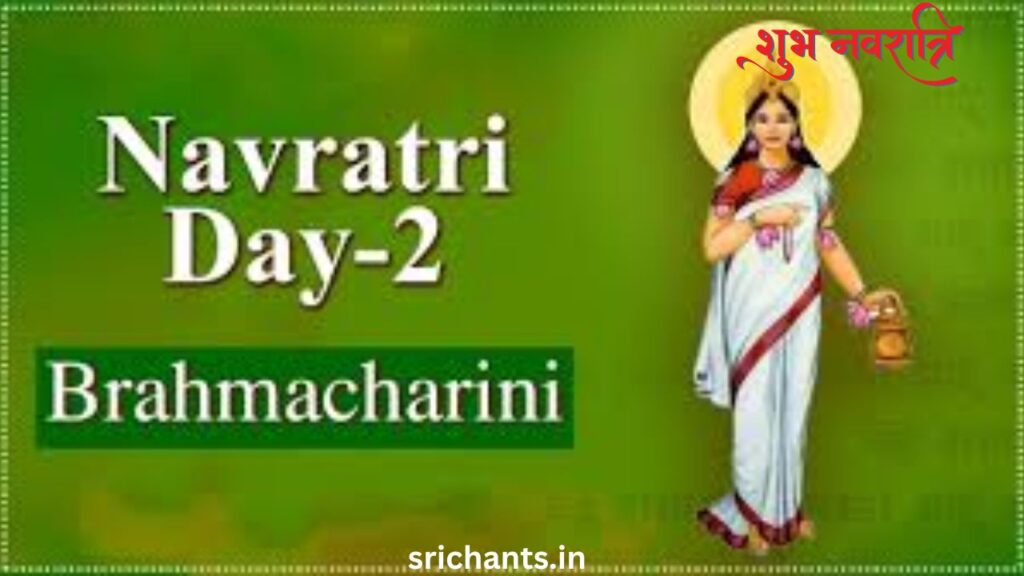Navratri Day 8: Maa Mahagauri : Unveiling the Radiant Essence of Navratri
Introduction
The eighth day, Ashtami, is the culmination of the magnificent celebration of Navratri, a nine-day festival that pays tribute to the divine feminine. This auspicious event is in honor of the revered deity Mahagauri, whose name encapsulates her essence of transcendent purity and grace. We are invited to embark on a voyage to uncover the profound significance, captivating rituals, and transformative tales associated with Maa Mahagauri as devotees worldwide immerse themselves in the divine energies of this sacred day.
The Essence of Mahagauri: Embodying Purity and Serenity
The appellation “Mahagauri” is a testament to the goddess’s divine nature, with “Maha” representing her supreme status and “Gauri” denoting her fair complexion. Mahagauri is frequently depicted wearing a white saree, which serves as a representation of her purity and tranquility. She is characterized by a luminous, ivory-hued complexion and a serene countenance. Her four-armed form gracefully carries a damaru and a trident, while the other two hands are positioned in the Varada and Abhaya mudras, bestowing blessings and dispelling concerns.
The majestic white bull, Mahagauri’s mount, serves to underscore her ability to offer stability and security to her followers and her connection to the earth. Mahagauri is held in high regard for her ability to alleviate the sufferings of her devotees and direct them toward a life of harmony and fulfillment, as she is the embodiment of spiritual enlightenment and serenity.
The Transformative Tale of Maa Parvati’s Journey to Mahagauri
The captivating narrative of Maa Parvati’s transformation into the revered Mahagauri is a testament to the divine’s immeasurable grace and the power of devotion. Parvati, the consort of Lord Shiva, initiated a profound penance in order to secure her beloved Lord as her spouse, as per Hindu mythology. Parvati’s complexion darkened as a result of the rigors of her spiritual practice and the nature’s elements during this arduous voyage.
Parvati, who was distressed by her altered appearance, sought the advice of Lord Brahma, the Creator. Brahma recommended that she immerse herself in the sacrosanct waters of the Ganges River and the Mansarovar Lake, assuring her that this divine ablution would restore her fair complexion. Parvati immersed herself in these sacred waters with unwavering faith, and upon her return, her dark skin separated, unveiling a radiant and serene form that embodied Mahagauri.
This transformative narrative exemplifies the divine’s capacity to cleanse and elevate the seeker, transforming them from the depths of darkness into the luminous light of spiritual enlightenment, and the power of devotion. We are encouraged to trust in the divine grace that can elevate us from the trials of life, as Mahagauri’s story inspires us to embrace our own journeys of self-discovery.
Rituals and Observances of Mahagauri Puja
Devotees perform a multitude of rituals to commemorate the divine presence of Mahagauri on the auspicious Ashtami, or the eighth day of Navratri. The day commences with the ceremonial bathing of the goddess’s idol in the sacred waters of the Ganges or other purified sources. The purification of the devotee’s own mind and spirit is symbolized by this symbolic purging.
The goddess is then dressed in pristine white attire by devotees, as white is the color that Mahagauri most adores. The tranquil ambiance is further enhanced by the use of fragrant white flowers, including lotus and jasmine, to decorate the deity. Sweets, dried fruits, and other auspicious items are presented as a humble expression of gratitude and devotion, concluding the ritual offering.
The observance of Kanya Puja, which honors young females as embodiments of the divine feminine, is a significant component of the Mahagauri puja. In the belief that the devotees will receive the blessings of the deity herself by honoring the divine in their pure, childlike forms, these “Kanyas” are ceremoniously bathed, adorned, and offered delectable delicacies.
The Aarti ceremony, a heartfelt expression of reverence for the deity, is performed by devotees, who also engage in meditation and chant mantras throughout the day. The Mahagauri Mantra, “Om Devi Mahagauryai Namah,” is recited with fervor to invoke the blessings of the supreme deity.
The Significance of Mahagauri in the Navratri Celebration
The eighth day of Navratri, which is in honor of the Goddess Mahagauri, is of particular importance in the context of the nine-day festival. It is a critical juncture, as the penultimate day, that connects the fierce and protective forms of the divine feminine, such as Kaalratri and Chandraghanta, to the more serene and benevolent aspects exemplified by Siddhidatri on the final day.
Mahagauri’s significance in this continuum is essential, as she symbolizes the transition from the darkness of ignorance and suffering to the radiant light of spiritual enlightenment. The seeker can emerge with a renewed sense of purity, strength, and inner serenity by overcoming even the most challenging obstacles through devotion, penance, and the grace of the divine, as her presence on this day serves as a reminder.
Additionally, the Hindu tradition’s profound reverence for the feminine divine is emphasized by the observance of Kanya Puja on Maha Ashtami. Devotees recognize the inherent divinity and sacredness of the feminine principle, which is the very foundation of Navratri’s celebration, by honoring young females as embodiments of the goddess.
The Blessings and Boons of Mahagauri
It is believed that devotees who offer their heartfelt prayers and devotion to Goddess Mahagauri on this auspicious day will receive a multiplicity of blessings and boons. Primarily, Mahagauri’s radiant presence is believed to dispel the darkness of ignorance and replace it with the light of wisdom and serenity, thereby alleviating suffering, anguish, and confusion from their lives.
In addition, Mahagauri is regarded for her capacity to establish and fortify enduring relationships, which endows her followers with a sense of unwavering loyalty and harmony in their personal and social lives. Mahagauri’s grace is believed to remove obstacles and open the doors to fulfillment and success, and devotees also expect to attain prosperity, abundance, and overall well-being by seeking her blessings.
Mahagauri’s beneficent influence is especially significant for those who are in pursuit of spiritual enlightenment, as she is believed to orient the aspirant toward the path of truth, self-realization, and the ultimate union with the divine. Her divine presence is a source of inspiration and hope, enabling her followers to transcend the constraints of the material world and embrace the boundless potential of the spiritual domain.
Mahagauri’s Connection to the Cosmos
Mahagauri’s divine presence is intricately interwoven into the cosmic order in the rich tapestry of Hindu mythology. The deity Parvati is the source of Mahagauri’s divine essence, and it is believed that the planet Rahu, which is renowned for its malefic influence, is under her control.
This connection to Rahu implies that Mahagauri’s influence extends beyond the earthly domain, encompassing the celestial realms and the complex dance of the planets and stars. Devotees frequently seek Mahagauri’s benediction in order to mitigate the adverse effects of Rahu, as they are of the opinion that the goddess’s grace can offer protection and direction in the face of the obstacles presented by this planetary influence.
Furthermore, the Ashtami tithi, or the eighth lunar day, is in accordance with the auspicious scheduling of Mahagauri’s worship during the Navaratri festival. The profound connection between the goddess and the rhythms of the cosmos is emphasized by this celestial synchronization, which reinforces the belief that her divine intervention can harmonize the energies of the universe and bring about balance and harmony in the lives of her devotees.
Mahagauri’s Manifestations and Iconography
Goddess Mahagauri is frequently depicted in a variety of forms, each with its own unique iconographic representation and symbolic significance. One of the most prevalent representations depicts her as a serene and radiant figure, wearing an immaculate white saree, and seated atop a majestic white bull, her mount.
Mahagauri is frequently depicted in this form with four arms, two of which are holding a trident and a damaru (a small hand-drum), and the other two are in the Varada and Abhaya mudras, which represent the bestowal of boons and the dispelling of anxieties. This iconography depicts her as the embodiment of spiritual enlightenment, the bestower of favors, and a protector.
A different representation of Mahagauri depicts her with ten limbs, each of which is either holding a symbolic object or wielding a distinct weapon. Dashabhuja Mahagauri, the goddess’s multidimensional form, symbolizes her capacity to overcome the forces of ignorance and darkness.
It is intriguing that Mahagauri is also linked to the Ardhanarishvara form in certain regional traditions, which represents the divine union of Shiva and Parvati. The goddess is depicted as the left half of the androgynous deity in this representation, which serves as a representation of the divine’s inextricable connection between the masculine and feminine principles.
The Significance of Mahagauri’s Color and Mount
Within the Hindu tradition, the immaculate white complexion of Goddess Mahagauri possesses profound symbolic significance. The goddess’s essence of spiritual enlightenment, purity, and serenity is closely associated with white, which is considered the most auspicious and pure of all hues.
This radiant hue is interpreted as a representation of the goddess’s capacity to purify the devotee’s mind and soul by eliminating the impurities of ignorance and negativity. The white saree she wears is a visual representation of the transformative power at work, symbolizing the devotee’s personal journey from the darkness of doubt and suffering to the luminous light of wisdom and inner serenity.
The symbolic significance of Mahagauri’s color and iconography is further emphasized by her mount, the majestic white bull. The bull, a sacred animal in Hindu mythology, is frequently linked to the stabilization, fortitude, and grounding of spiritual energies. Mahagauri is regarded as the embodiment of unwavering determination, unshakable faith, and the capacity to provide a steadfast foundation for her devotees to navigate the challenges of life by mounting this powerful creature.
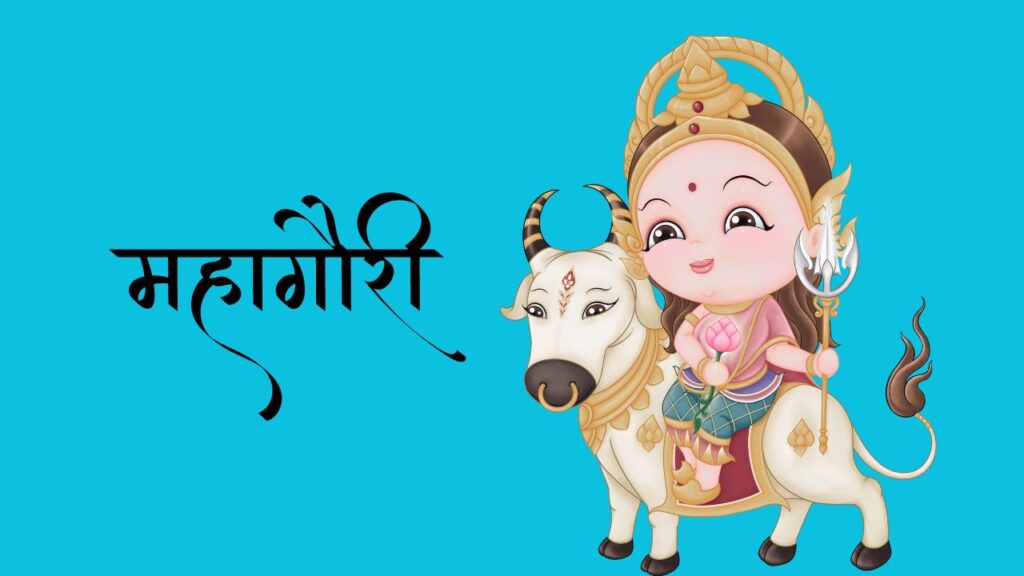
The Boon of Mahagauri’s Grace
The rewards and bounties that are believed to be truly profound and transformative are bestowed upon those who wholeheartedly surrender themselves to the divine presence of Goddess Mahagauri. One of the most significant benefits is the reduction of suffering, anguish, and confusion in the devotee’s life.
Mahagauri’s radiant energy is purported to dispel the darkness of ignorance, replacing it with the luminous light of wisdom and inner serenity. Through her grace, devotees can obtain solace and relief from the trials and tribulations that weigh heavily on their hearts and minds, thereby enabling them to live a life of spiritual development, fulfillment, and harmony.
Additionally, Mahagauri is regarded for her capacity to nurture unwavering loyalty among her devotees and fortify the bonds of relationships. By pursuing her blessings, individuals can experience the profound pleasure of establishing enduring connections in both their personal and social lives, as well as find comfort in the embrace of a supportive community.
Mahagauri’s beneficent influence is equally significant for those who aspire to material prosperity and affluence. It is believed that her grace empowers her devotees to thrive in the physical sphere while maintaining a steadfast connection to the divine, removing obstacles and opening the doors to success, wealth, and overall well-being.
Mahagauri’s guidance to individuals who are pursuing spiritual enlightenment may be the most profound blessing she bestows. In order to achieve the ultimate union with the divine, devotees can embark on a transformative voyage towards self-realization by aligning themselves with the goddess’s radiant essence.
The Enduring Legacy of Mahagauri
For centuries, the veneration of Goddess Mahagauri has been interwoven into the intricate tapestry of Hindu tradition and culture. She is a revered figure in the hearts and minds of devotees throughout the Indian subcontinent and beyond due to the profound blessings associated with her worship, divine iconography, and captivating story.
The eighth day of the Navaratri festival, which is dedicated to Mahagauri, serves as a profound reminder of the transformative power of the divine feminine. Devotees are motivated to embark on their own voyages of self-discovery by her example, placing their faith in the divine grace that can transform them from the depths of darkness into the radiant light of spiritual enlightenment.
Devotees continue to seek Mahagauri’s blessings in order to achieve solace, harmony, and fulfillment in their lives, as her legacy continues to resonate. Her eternal presence serves as a beacon of hope, reminding us that the divine’s infinite grace can lead us to a life of purity, wisdom, and unwavering faith, even in the face of adversity.
Conclusion
The Mahagauri celebration on the eighth day of Navratri is a profound and transformative experience that encourages devotees to fully embrace the resplendent essence of the divine feminine. We are reminded of the power of devotion, the grace of the divine, and the inherent divinity that resides within each of us through the captivating tales, sacred rituals, and bountiful bounties associated with this goddesss.
Let us adopt Maa Mahagauri’s message of spiritual enlightenment, serenity, and purity as we pay tribute to her. May the light of her presence dispel the obscurity of ignorance and direct us toward a life of unwavering faith in the divine, fulfillment, and harmony. For in the worship of Mahagauri, we discover the keys to unleashing the boundless potential that resides within, enabling us to transcend the constraints of the material world and bask in the infinite grace of the divine.
